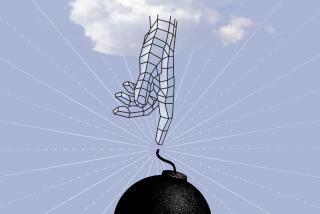Out-of-Control Technology Becomes a New Government Dictator
- Share via
The greatest problem facing government, large and small, throughout the country is technological progress. In its present and unmanaged state, technology is dictating our societal priorities and placing new and expanding demands on our taxpayers, rather than being used to support and improve the life style and social values that we deem most important. In short, our technology is out of control, and managing it will require facing up to some basic moral and economic decisions that most of us would rather not confront.
Government in this country has traditionally been supply-management-oriented. Problems usually were defined as “not enough of.” Solutions were defined as spending money to “get more of.” For example, the problem of increasing amounts of solid waste was viewed as not enough money to build more landfills. The solution was defined as generating more money to build more sites. A demand-management perspective would define the problem as too much waste and the solution as reducing the amount of waste. Demand management focuses on ways in which government can help reduce the demand for its services and products. Demand management emphasizes prevention rather than treatment, conservation rather than production, recycling rather than throwing away. It focuses on changing consumer behavior to reduce the demands on government services.
Demand management recognizes the crucial distinction between the consumer and the taxpayer. The taxpayer often pays no matter how much government service is used. The consumer pays only according to use. From a social-justice standpoint, certain services should not be allocated on the basis of one’s willingness to pay, but in a great many areas government could tighten the connection between service and payment, thus reducing demand without causing social inequities.
When a government service or product appears to be free (even though it is paid for by all taxpayers), it will be used in greater volume than if a fee were placed directly on the user. And when the cost is spread among all taxpayers, as opposed to only the actual consumer of the product, the illusion is created that the product is cheaper than it really is. Consequently, more of the product or service is demanded and more is used, forcing government to grow larger to provide an ever-increasing supply.
One well-meaning but subtle way in which technology induces us to spend more is through the development of increasingly higher standards for buildings and safety. In general, higher standards improve our quality of life. The crunch comes when our technology with its endless possibilities is exposed to a legal system that says, “If we can technically do it, we must do it or be sued.” Our technology then becomes our albatross, the true dictator of our social priorities, the real legislator of our country’s values.
Seen in this light, technology inherently is leading to expansion of the cost and scope of government. It focuses governmental expenditures on treatment solutions, often at extremely high cost, at the expense of prevention, which is often less costly. It causes us to over-design, overoperate and over-build in order to escape the cost of being held liable by a judge.
The examples of technologically induced demand for governmental expenditures are numerous:
--The architect who employs “defensive” design to prevent possible lawsuits.
--The emphasis that we tend to place on providing fire suppression rather than on fire prevention, such as mandating sprinkler systems and inspections.
--Our willingness to subsidize the least productive, most expensive forms of energy, rather than conservation practices and investments.
In a contest between treatment and prevention, treatment wins because it is what our technology does best--fix things after they’re broken. Prevention, on the other hand, is a slow and continual process, depending much more on individual responsibility.
The most sobering point of all is that technology is forcing the government to play God. In times past, the technology did not exist to eliminate or modify what were understood to be natural occurrences. This has changed. Because we increasingly have the technology (but not the money) to keep bad things from happening, and because our judicial system increasingly says that we must use that technology, now everything is considered to be “in the control of”--or the fault of--a person, an institution or a government. These tangible entities are “to blame.” Our legal system has no room for such concepts as quirks of nature or acts of God.
Our future depends more on our ability to make good judgments about the right and wrong applications of technology than it depends on future technological breakthroughs. If we first deal with fundamental economic and moral questions about the application of costly technology, we can learn to manage that technology, and the future will be brighter.
More to Read
Inside the business of entertainment
The Wide Shot brings you news, analysis and insights on everything from streaming wars to production — and what it all means for the future.
You may occasionally receive promotional content from the Los Angeles Times.










